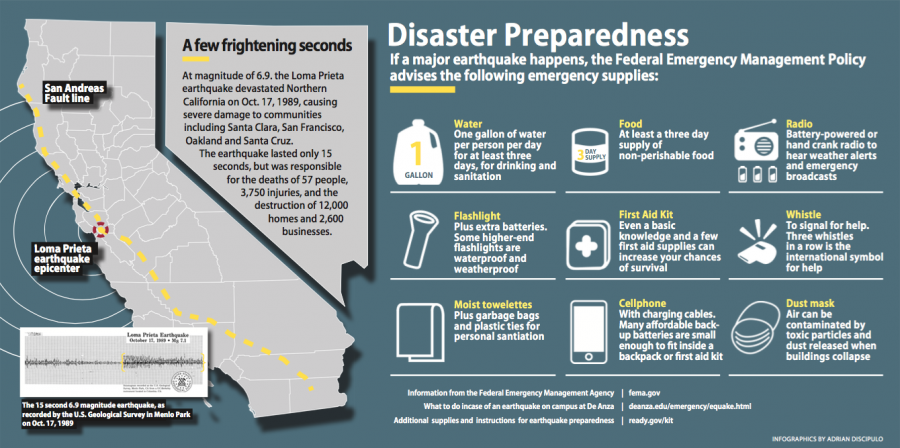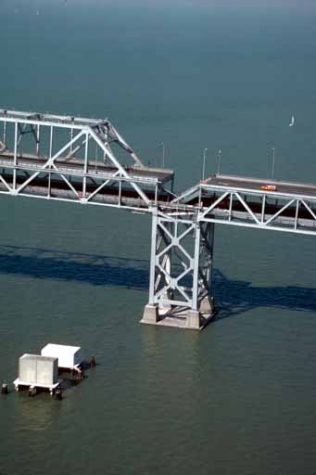Earthquakes: De Anza ready for the forecasted big one?
While the college prepares for next big earthquake, many De Anza students dob't know what to do on campus or to how to prepare at home.
June 9, 2016
A few minutes past 5 p.m., Mary Kay Englen sat at her desk in the Learning Center building on the De Anza College campus. As she talked with a friend at the end of her day, the building began to shake, as if a train hit it.
“Oh my God!” Englen’s friend said over the phone. “We’re having an earthquake!”
And then, the phone line went dead.
“All of a sudden, everything started rocking and rolling,” said an unidentified campus contractor. “I tripped over my desk trying to get out of my office, and it took all night to get home.”
Englen, senior program coordinator of Staff and Organizational Development, and three other staff members left in the office reacted quickly. One of them got under his desk just moments before a heavy wood-framed bulletin board fell off the wall and landed right where he had been sitting.
The earthquake lasted 15 seconds.
“It was like time was standing still,” Englen recalled.
After the shaking stopped, Englen and her colleagues emerged from under their desks and hurried into an adjoining reading room. As they entered the room, they saw students climbing out from under he heavy oak study carrels.
They walked through the first-floor library area and saw the floors covered with three feet of books shaken from the shelves.
Englen said she didn’t see anyone panic. The safety plans the staff had developed helped everyone get out of the building, and no one was hurt.
When the magnitude 6.9 Loma Prieta Earthquake struck Santa Cruz and the San Francisco Bay Area 27 years ago, it killed 57 people and injured another 3,757. It was the most expensive natural disaster to date, causing $6 billion in damage region wide.
Next time, it could be even worse.
In an unscientific poll of 40 De Anza students, 68 percent of those surveyed said they knew what to do in the event of an earthquake.
Many of those who responded described getting under a table – which is correct. Others said they would either stand in a doorway or go outside, and these are not the right things to do.
“I think I know what to do,” one student responded. “But no, I’m not ready for the big one.”
The coastal regions surrounding the Pacific Ocean, commonly known as the Ring of Fire, have more faultlines slipping and grinding than anywhere else on Earth. This is where most of the world’s major earthquakes happen.
The west coast of the United States has been lucky. In the last five years, only one major earthquake shook the U.S. west coast, according to the United States Geological Survey. The rest of the Ring of Fire experienced 226 earthquakes of the same magnitude during that time period.
The consensus among scientists is that the San Francisco Bay Area has a 99 percent probability of experiencing a magnitude 6.7 earthquake within the next 30 years. Disaster preparedness experts are quick to point out that, while we don’t know exactly when the next big earthquake will happen, the most sensible course of action is to be prepared for the inevitable.
Fewer than a half of the 40 students surveyed said they had the recommended three days supply of food and water at home. About 20 percent of the respondents were uncertain about what to do either on campus or at home.
Think about it. After you get out from under your desk or table, will you be able to hop in your car and go home? Probably not.
During the Loma Prieta quake, fallen utility lines blocked the streets. Electrical outages cut the power to traffic signals. And the police, fire and other emergency responders kept drivers from using the roads. You could be stuck on campus.
“While we haven’t had an earthquake drill in a few years, we will be trying to schedule an exercise for this summer or fall,” said Donna Jones-Dulin, associate vice president for Campus Operations.
De Anza College staff and faculty have developed earthquake response plans as part of the campus’ Emergency Operations Center training. According to Jones-Dulin, De Anza’s emergency response plan was most recently updated past April. Jones-Dulin also pointed out that the campus maintains a store of emergency supplies, referred to as the Ark, in partnership with the City of Cupertino.
To cope with the possibility of students, faculty and staff being stranded on campus, Jones-Dulin said that the campus has supplies in the Dining Services operations that can be used for 24-36 hours. In addition, if necessary, the college would ask the Red Cross to designate De Anza as an emergency shelter. In this instance, they would provide those sheltering on campus with additional supplies.
Knowing what to do helped keep people safe the last time. Take some time to learn about what you need and what to do in the event of an earthquake or other emergency.



